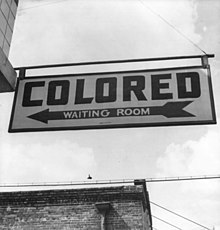User:Shawnie286/Sample page
Discrimination in nursing can take many different forms and occur at different intensities. Patients may request white nurses and reject nurses of color. Healthcare institutions may overlook nurses of color for leadership roles or fail to appoint a diverse nursing workforce that reflects the communities they serve. Furthermore, because they are not immune to unconscious prejudice, nurses may choose treatments based on cultural, ethnic, or gender preconceptions. This can lead to patients receiving subpar pain management, erroneous diagnoses, and unfavorable health consequences.
To what extent is the issue widespread? Forty percent of nurses who participated in a new PLOS One study said they had encountered discrimination in a medical setting.
Nursing prejudice
[edit]
Peers who are nurses can be discriminatory.[1] When it comes to one or more of their personal traits, nurses may encounter discriminatory acts from other nurses who have misinformed or biased attitudes and views. Based on variables like age, gender, or place of origin, they could draw harmful conclusions about their nursing knowledge or skill level.
Instances of discriminatory behavior among nurses include overt bigotry, such using racial insults, as well as more covert forms, like microaggressions. Microaggressions are biased behaviors that dehumanize, undermine, and belittle the people they target. They might take the form of acts or remarks. A nurse informing a non-white coworker who was born in the United States,
Racism ——————————————————————————
[edit]
It seems that the terms "racism" and "racist" are very new; there are no documented citations that indicate these terms were in use before the early 1900s. However, this does not mean that racism was not an idea in the distant past, only because the terms are relatively recent. Things can exist for a long time before being given names; the term "spaceship" was coined in the 19th century, long before rocket-powered vehicles were created. For Example, The term "T-shirt" was first printed in print in the 20th century, despite the fact that the article of clothing was around before 1900. Frequently, dictionaries are regarded as the last arbiter in disputes about definition of a word, but they're not necessarily the best tools for resolving conflicts.
Racism is more than just overt prejudice, which is obvious when it manifests itself in ways like yelling obscenities or making offensive jokes. Thus, without properly defining the term, it is pointless to begin a conversation on racism in the workplace. Surprisingly, dictionaries may not adequately cover subtle racism because there are numerous definitions of what precisely qualifies as racism.[2]
Contents———————————————————————————
[edit]- Prejudice
- Racism
- Minority Groups
- Bias
Minority Groups—————————————————————————
[edit]Here are some of the minority groups effected by Prejudice in the work Place and in society
- Muslims
- Hispanics
- Asians
- Jews
- White People/ mainly those of different religious backgrounds
- LGBT members
Psychology behind it————————————————————————
[edit]Favoring or treating members of one racial group better than another is known as racial bias. Without a doubt, the strategy of concentrating on discrimination and individually held racial preconceptions has yielded important insights into the psychology of racial biases. Nevertheless, this method mainly overlooks how racial biases are influenced by larger cultural systems in which individuals live as well as their systemic nature For example, the emphasis on personal prejudices has fueled the growth of the implicit bias and diversity training industries, which seek to solve issues like Black people being brutalized by the police.
Racial bias is influenced by five major systemic elements that are present at all nested levels of this framework: shared preconceptions, segregated communities, power and privilege discrepancies, and nonverbal messaging. We concentrate on these five systemic elements because we think they are particularly significant to the evolution of racial biases in the modern USA, even though they are by no means the only ones. The closest factors influencing an individual's level of racial bias are those that occur within, such as interpersonal and personal experiences like being socialized by caregivers and making friends who are not of the same race. The ethnic variety of a school or neighborhood community, for example, sets the local framework for interpersonal relationships that these experiences are nested within. The rules, values, and ideas that make up society are shaped by the larger cultural framework in which communities are situated. The outermost degree of influence is temporal influence, which describes how individuals in society are influenced throughout their lives by past interpersonal, institutional, or community effects. The effects of each level of influence on attitudes at the individual level are the main focus, but the levels also have an impact on each other. For example, prejudices at the individual level can be shaped by culture, as can organizations and interpersonal experiences within that culture. Similarly, racial biases at the individual level can influence interpersonal experiences, which in turn can influence elements at the organizational and community levels.
Reference section
[edit]- ^ University, Duquesne (2024). "Discrimination". University. Sample publisher. Retrieved 27 January 2024.
{{cite web}}: CS1 maint: url-status (link) - ^ Magazine, Forbes (7 April 2023). "Forbes Magazine". The Sample Times. Retrieved 27 January 2024.
{{cite news}}: CS1 maint: url-status (link)

